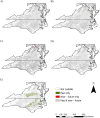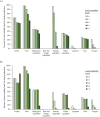Exploring the crop suitability of first-contact tribal lands in the eastern United States: impacts of past and near-future climate conditions
- PMID: 40739401
- PMCID: PMC12311056
- DOI: 10.1038/s41598-025-13581-4
Exploring the crop suitability of first-contact tribal lands in the eastern United States: impacts of past and near-future climate conditions
Abstract
Indigenous communities in the United States have experienced a long history of land displacement, disrupted food systems, and inadequate federal services, which have contributed to nutrition-related health disparities. Initiatives to support Indigenous agriculture may help address these injustices, yet little is known about the agricultural crop suitability of tribal lands, especially under future climate conditions. This study fills this gap by developing geoclimatic forecasting models that quantify the agricultural potential of all 24 first-contact tribal lands in Virginia, Maryland, and North Carolina. Geoclimatic models included stationary variables (soil texture, salinity, drainage, and pH; elevation; and slope) and dynamic variables (monthly and annual precipitation, and monthly temperature). Tribal representatives and community leaders were partners in this research to protect Indigenous data sovereignty, ensure cultural relevance of the research design, and provide tribe-specific data on land delineations. By 2040, optimal agricultural land was predicted to decrease by 27% (1.525 km2) and the number of culturally relevant crop species was predicted to decrease by 36% (from 11 to 7). These findings provide context for policy initiatives that have emerged or accelerated to restore environmentally sensitive agricultural areas, support new and existing Indigenous food producers, and strengthen consumer markets for Indigenous food products.
Keywords: Agriculture; Climate; Food sovereignty; Indigenous; Sustainable; Tribe.
© 2025. The Author(s).
Conflict of interest statement
Declarations. Competing interests: The authors declare no competing interests. Ethics declarations: This study was approved by the Institutional Review Board at William & Mary (PHSC-2024-09-17-17239). All participants provided written informed consent. This study was funded by the Jeffress Trust Awards Program in Research Addressing Health Equity. The funder had no role in the conceptualization, design, data collection, analysis, decision to publish, or preparation of the manuscript. ZC has research awards from the US Department of Agriculture and National Pork Board for activities unrelated to the present study.
Figures




Similar articles
-
A comprehensive crop suitability assessment under modern irrigation system in arid croplands.PLoS One. 2025 Jun 18;20(6):e0326183. doi: 10.1371/journal.pone.0326183. eCollection 2025. PLoS One. 2025. PMID: 40531976 Free PMC article.
-
Sexual Harassment and Prevention Training.2024 Mar 29. In: StatPearls [Internet]. Treasure Island (FL): StatPearls Publishing; 2025 Jan–. 2024 Mar 29. In: StatPearls [Internet]. Treasure Island (FL): StatPearls Publishing; 2025 Jan–. PMID: 36508513 Free Books & Documents.
-
Modeling impacts of climate-induced yield variability and adaptations on wheat and maize in a sub-tropical monsoon climate - using fuzzy logic.Sci Rep. 2025 Jul 16;15(1):25882. doi: 10.1038/s41598-025-09820-3. Sci Rep. 2025. PMID: 40670520 Free PMC article.
-
Behavioral interventions to reduce risk for sexual transmission of HIV among men who have sex with men.Cochrane Database Syst Rev. 2008 Jul 16;(3):CD001230. doi: 10.1002/14651858.CD001230.pub2. Cochrane Database Syst Rev. 2008. PMID: 18646068
-
The clinical effectiveness and cost-effectiveness of enzyme replacement therapy for Gaucher's disease: a systematic review.Health Technol Assess. 2006 Jul;10(24):iii-iv, ix-136. doi: 10.3310/hta10240. Health Technol Assess. 2006. PMID: 16796930
References
-
- Maillacheruvu, S. U. The historical determinants of food insecurity in native communities. Center on Budget and Policy Priorities;2022. Available at: https://www.cbpp.org/research/food-assistance/the-historical-determinant... (verified 24 April 2024).
-
- US Government Accountability Office. Resource constraints and management weaknesses can limit federal program delivery to tribes. (2019). Available at: https://www.gao.gov/products/gao-20-270t (verified 24 April 2024).
-
- Rabbitt, M. P., Hales, L. J., Burke, M. P. & Coleman-Jensen, A. April. Household food security in the United States in 2022. US Department of Agriculture, Economic Research Service;2023. (2024). Available at: https://www.ers.usda.gov/topics/food-nutrition-assistance/food-security-... (verified 24).
MeSH terms
LinkOut - more resources
Full Text Sources
Medical
Miscellaneous

